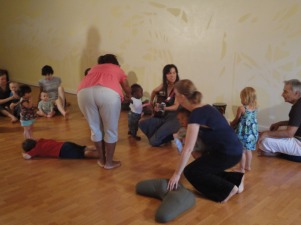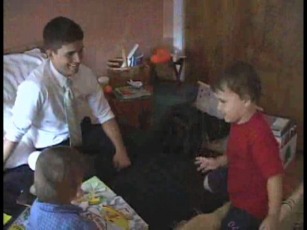Babies and Signs

Gina Ferragame leading a baby sign class
The use of sign language has always been associated with communicating with those unable to speak. However, in this relationship a large component of the population that is unable to speak is often left out—babies.
Why Use Baby Signs?
Every new mother longs for the day when she will be able to communicate with her child. Before a child can speak, parents are riddled with questions: “Why is he crying?”, “Is he still hungry?”, “Does he feel sick?” Some of the overbearing worries of parenting could be alleviated if parents could only understand what their child was trying to express. Well, fortunately successful communication between parent and child no longer has to be a fantasy. Parents across the county are catching on to the phenomenon of using American Sign Language (ASL) to communicate with their young children.
“When they can communicate with me and I can respond it just feels so good as a mother,” says Gina Ferragame, a mother of two who uses Baby Signs and ASL to communicate with her boys.
Why Use Baby Signs?
Every new mother longs for the day when she will be able to communicate with her child. Before a child can speak, parents are riddled with questions: “Why is he crying?”, “Is he still hungry?”, “Does he feel sick?” Some of the overbearing worries of parenting could be alleviated if parents could only understand what their child was trying to express. Well, fortunately successful communication between parent and child no longer has to be a fantasy. Parents across the county are catching on to the phenomenon of using American Sign Language (ASL) to communicate with their young children.
“When they can communicate with me and I can respond it just feels so good as a mother,” says Gina Ferragame, a mother of two who uses Baby Signs and ASL to communicate with her boys.
Gina's story
Gina began teaching her 3-year-old son, Theo, to sign as an infant and now that he is older she says the benefits are enormous, “What I'm seeing, in his development, is not only his ability to communicate through words, but to acknowledge the baby, his brother.”
Gina says what really gets it for her is when they say we love each other. She says "that's just beautiful.”
Are baby signs actually helping kids?
If this tool is so effective why isn’t it more popular? According to UC Davis Professor, Dr. Linda Acredolo, many parents are hesitant to teach their children sign language out of fear that it will prolong the time until they actually speak.
Gina began teaching her 3-year-old son, Theo, to sign as an infant and now that he is older she says the benefits are enormous, “What I'm seeing, in his development, is not only his ability to communicate through words, but to acknowledge the baby, his brother.”
Gina says what really gets it for her is when they say we love each other. She says "that's just beautiful.”
Are baby signs actually helping kids?
If this tool is so effective why isn’t it more popular? According to UC Davis Professor, Dr. Linda Acredolo, many parents are hesitant to teach their children sign language out of fear that it will prolong the time until they actually speak.
Research performed by Dr. Acredolo and others, however, shows these fears are unwarranted, “We found that, in fact, those children who had signed as babies were excelling at intellectual development.” Her study from 2000 found that 3-year-olds who learned American Sign Language showed the communication skills of a 4-year-old. And by age 8, those same children outperformed those who hadn’t learned ASL by an average of 12 IQ points.
Doctor Vic Strasburger of the American Academy of Pediatrics says, “Parents have been hoodwinked into thinking that infant videos will make their kids smarter…parents need to understand that they are the single most important source for their babies.”
Doctor Vic Strasburger of the American Academy of Pediatrics says, “Parents have been hoodwinked into thinking that infant videos will make their kids smarter…parents need to understand that they are the single most important source for their babies.”
Why it matters:
Though the educational and developmental benefits abound, Dr. Acredolo says these are not the core reasons why she promotes the use of ASL with young children, “Even though we know signing helps intellect, we promote it because of the emotional benefits. Frustration levels are lower and they feel connected at a lower age.”
Gina Ferragame couldn’t agree more, “When they say we love each other ... that's just beautiful.”
The use of sign language has always been associated with communicating with those unable to speak. However, in this association a large component of the population that is unable to speak is often left out—babies.
Though the educational and developmental benefits abound, Dr. Acredolo says these are not the core reasons why she promotes the use of ASL with young children, “Even though we know signing helps intellect, we promote it because of the emotional benefits. Frustration levels are lower and they feel connected at a lower age.”
Gina Ferragame couldn’t agree more, “When they say we love each other ... that's just beautiful.”
The use of sign language has always been associated with communicating with those unable to speak. However, in this association a large component of the population that is unable to speak is often left out—babies.

